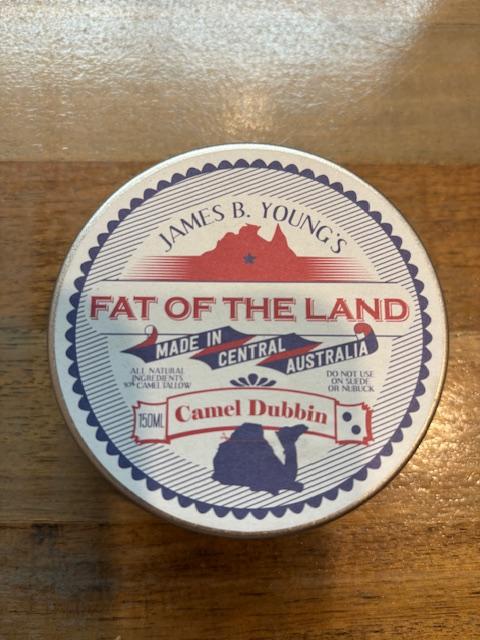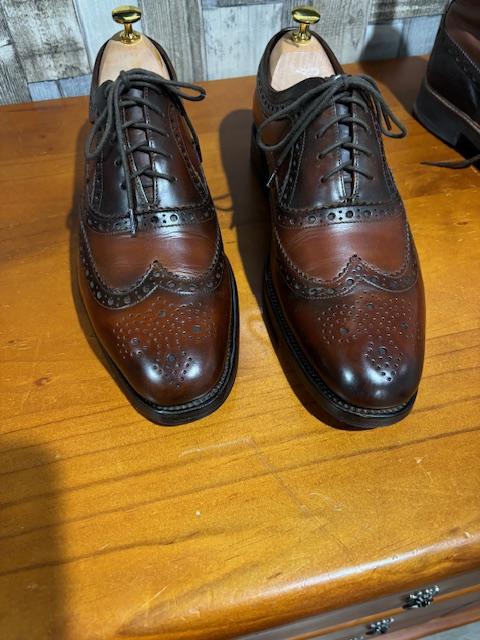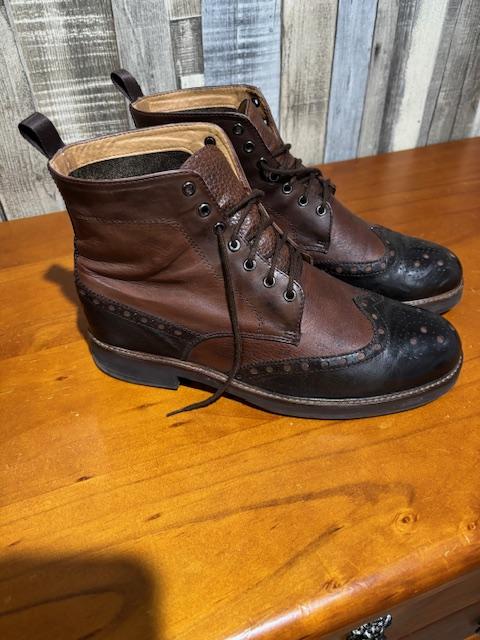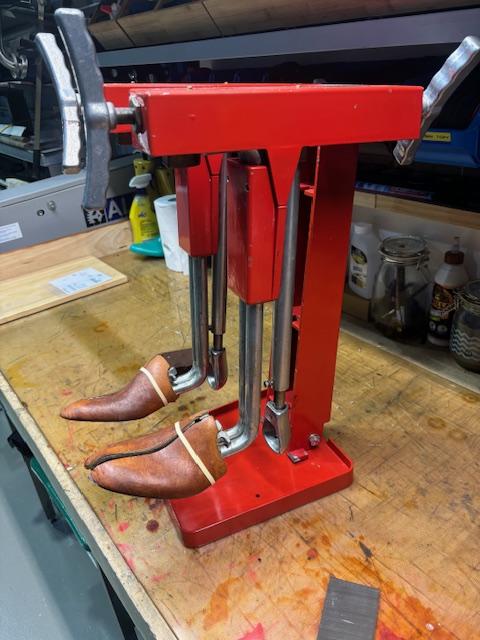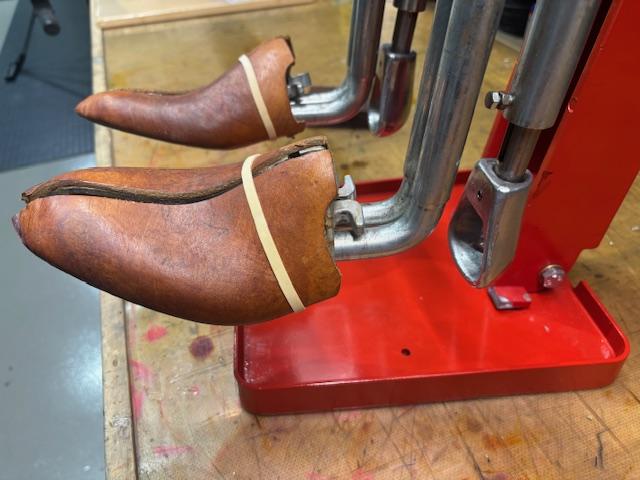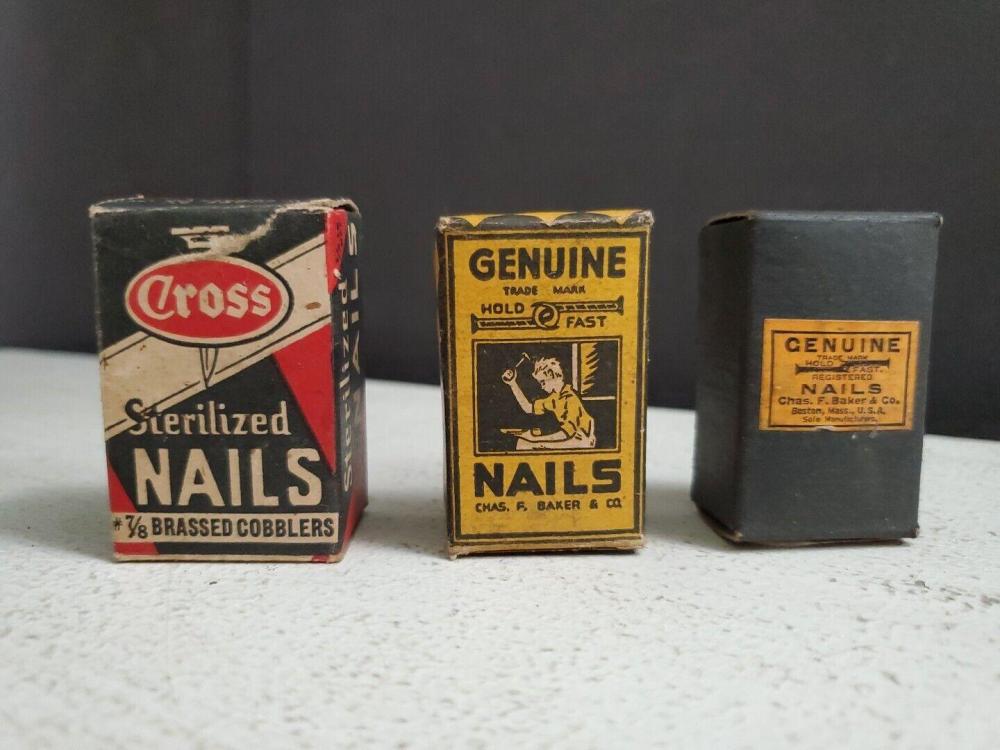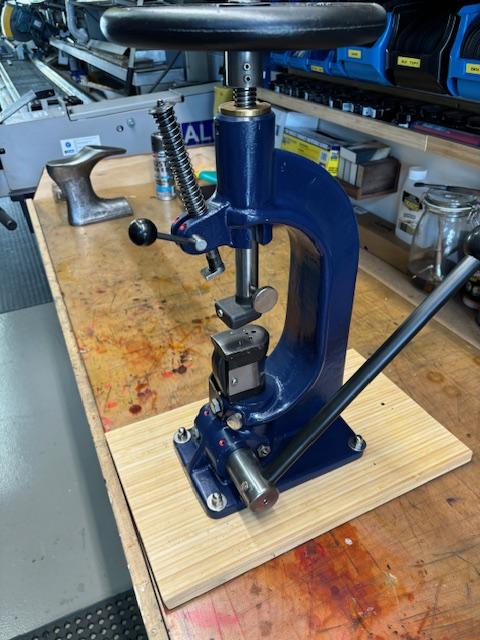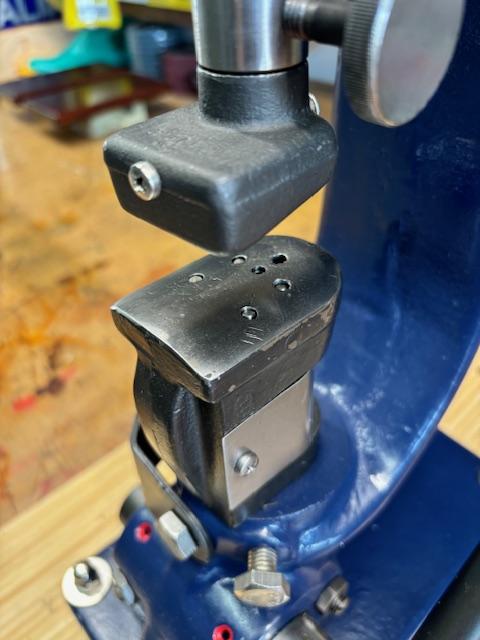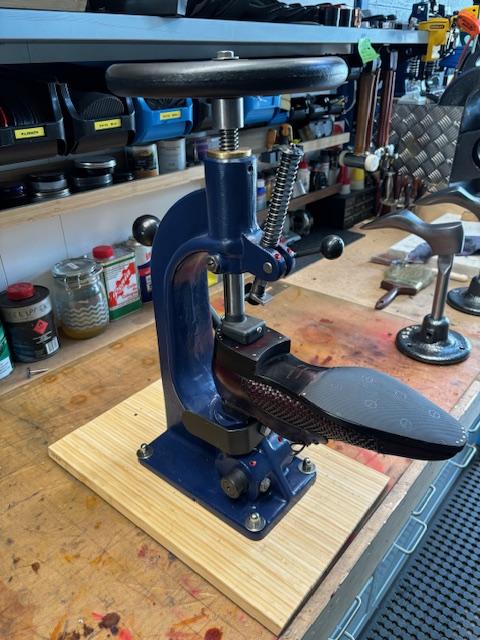Tastech
Members-
Posts
135 -
Joined
-
Last visited
Content Type
Profiles
Forums
Events
Blogs
Gallery
Everything posted by Tastech
-
With industrial machines its a horses for courses sort of deal . The machines are very specific when it comes to intended use . Walking foot versus roller foot is all about intended use . I mainly used a post bed machine for sewing shoe uppers because i can do the concave / convex parts with easy access . I prefer a roller foot because i can do tight curves and see what going on when i am making brogues. I also use a cylinder arm walking foot for other bits but mainly making bags. I use a flat bed roller foot for stitching the padding to shoe tongues and attaching that to the vamp. I even hand sew some features like apron and spit toes because i don't know of a machine that can do it You can cross over with machines but generally i use a specific machine for a specific task and even leather thicknesses . Ask yourself what specific task do you want the machine to do ? there will be a good machine out there that is perfect for the job . Even consider a new Chinese machine. they are generally clones of existing tried and true machines and to my surprise are really good and relatively cheap . I love the old legacy machine but most are obsolete and very hard if not impossible to get parts for .My preference is a treadle powered machine but after half an hour i get cramps and my hips hurt so i use a servo motor on all my main machines.However I just love the precision of a treadle when doing a wingtip brogue 2 mm off the edge around a tight curve . One really good advantage of a new machine with a servo motor is the reverse feature . No more turning the job around and having the roller where you don't want it and missing the same stitch hole. No one will ever notice it but i know its there and a little piece of me dies each time it happens .
-
@hugh123 I think 5mm would be about the limit using chrome tan. with the right needle and tension . The only thing i can see going wrong is if the needle cant punch through it may allow the needle shaft to slip from its timing setting . Open the side cover and make sure the needle shaft screw is tight before you start . Do a practice run using 3mm then 4 mm then 5mm which will give you a good indication of what to expect and to just get the feel of things . If you motor doesn't have enough torque to get through at a slower speed then a reduction wheel might be necessary. not for a lower speed but for higher torque. What sort of motor are you running ? Old school induction clutch motor or the new DC variable speed ?
-
@hugh123 I have both machines you mention .The 48 has a roller foot while the 15 has a flat foot . The roller/foot shaft is also different in both machines as in the needle clamps . The fundamental difference is that the bobbins and bobbin carriage are different . I use my machines for stitching shoe uppers up to 3.5mm overall thickness . Not sure what that is in ounces
-
Working boots last making
Tastech replied to Larryvaan's topic in Shoes, Boots, Sandals and Moccassins
@Larryvaan You have done a good job on the last and it looks quite usable however there are a few things to consider before commencing . Heel height for one . Its probably a good idea to have some sort of replaceable heel material . this can be as little as 6 mm or a few stacked leather thicknesses up to 20mm. If this is the case then the last needs to incorporate the heel height . I would allow and extra overall width of 6mm and some toe room of about 12mm in length and also toe box height .You dont feel it right away but after a couple of hours a big toe touching the top of the toe box can give you grief therefore at least 3mm clearance there as well. This can easily be done with gluing some sole leather to the sides and front and then skiving them into shape. But the best method to get an actual feel for the last is to make a sacrificial pair of shoes specifically to test the fit , you can then make the modifications to the last for the real pair . The test pair can be rough as hell , it doesn't matter . All you have to do is sew the upper but only glue down the sole . Wear them for a day in the way or environment you will use them and take a note of where if any changes need to be made . You may nail it first go but probably not . In the bespoke shoe trade it is standard to make up a mock sacrificial pair of shoes to test fitting before the real pair is made . with the customer present we get feed back and then to their horror we cut sections out to confirm toe room and width . A mock pair of shoes takes a couple of hours where the real ones can take between 20 to 40 hours so you want to get it right. Worse cones to worse you can always stretch out the width but length can be difficult. If you realise you have got it all wrong and making a new pair of last is to much trouble there is always the option of buying commercial lasts and going from there . On Etsy i have seen lasts from Ukraine that are what i call anatomically correct . some call them barefoot lasts . They are similar in shape to brikenstocks and crocs where the have a rounder toe area . The seller is called goodhusak. here is a link to show you. https://www.etsy.com/au/listing/1089736001/shoe-lasts-for-cowboy-40-47-sizes?ls=s&ga_order=most_relevant&ga_search_type=all&ga_view_type=gallery&ga_search_query=mens+shoe+lasts&ref=sr_gallery-1-13&bes=1&content_source=b01e6a2a4020411eadd45b61df19f14b1b9553e2%3A1089736001&search_preloaded_img=1&organic_search_click=1&logging_key=b01e6a2a4020411eadd45b61df19f14b1b9553e2%3A1089736001. Below is another link to show you the fitting of the sacrificial pair and what gets done to them during the fitting Bespoke Shoe Fitting With Legendary Lastmaker Tony Gaziano | Gaziano & Girling - YouTube I would like to see a drawing or photo of what style you had in mind and perhaps i can offer some advice . Regards Tas -
The skiving blade is easy . I do it this way . Using double sided tape on one side of the blade , Stick it to a bench with the sharp side over hanging the bench by about 1/4" . Your can use various grades of diamond sharpening plates or stones . when one side is done flip the blade and repeat . Surprisingly , the blade stays sharp for a very long time . As a shoemaker and cobbler i use mine about 20 to 50 times a day . Its been over a year since i last sharpened. Interesting fun fact . The skiving blade is the same width as a Stanley NO 4 hand plane blade . You can still get a new blade for the cutter from landis . Over time they lose their diameter and wont cut all the way through . The round blade on my machine is about 30 years old and is due for replacement soon.
-
Cutting soft or chrome tan leathers will always be troublesome . The tool was specifically designed to cut veg tanned kangaroo leather of a thickness of .8 mm to 1.2 mm. It is the relative stiffness of veg tan that makes cutting lace easy with the tool and the added fiber structure of kangaroo leather make cutting a breeze. Perhaps with a little practice and finesse you might be able to get good results with soft leather but i would not be hopeful.
-
@FDC Its been almost a year since your last post and i was wondering how the machine is getting along . Are you seeking therapy yet ?
-
I'm not really a fan of camels , spitty , ugly and temperamental animals that they are ( reminds me of some humans ) .However i am predisposed to a well presented foot . lol. I recently made the acquaintance of a fellow shoe maker and leather worker from Alice springs in central Australia . He gifted me a tin of his own brand of camel dubbin leather dressing made from the fat of the hump . I didn't think to ask about the source of this hump fat and how it was obtained let alone ask about the qualities of its leather . I do know that wild camels are rounded up and exported to the middle east for their meat but i am not sure if they are shipped live or as frozen meat . If they are shipped frozen then the skins are disposed of because i don't think there are any viable tanneries in or close to camel country . They may on the other hand be salted and exported green along with cowhides to tanneries around the world for processing into leather.To be honest i have never really given it much thought before. It could in theory be financially viable under some circumstances . You would need to round them up , pen them and transport then to an slaughter house . The skins would go to a tannery and the meat to be butchered . Camel hair is world renowned for its fineness and thermal properties but i think the wool is shorn at a certain time of year and you need i live tame live camel to do that . Is the meat tasty and marketable ? who knows . If i ever come across some i would be happy to give it a try. I am sure NSW lwaether could source you some if you wanted it .After all they sell veg tanned Kangaroo scrotum's , so why not camel leather About 40 years ago i met a bloke who lived out in the desert who was once a cameleer . He told me he made the saddle bags for his camels out of camel leather as well as old carpet. Again i didn't inquire further as he sort scared me and was as we say in Australia a bit on the nose . Below is a link to the website of James B young , the bloke from Alice .If you contact him he might be able to enlighten you and us all https://www.jamesbyoung.com.au/
-
@Andy132, A couple of things . With the photo resizing i use this method . Take a phone photo and send it to my email . before it send it asks me what size . small ,medium , large ,actual. I choose medium or small for this forum . I then open the email on my desktop and save . then post from there . Its a bit of a chore but it works . With the stripping down of the machine i follow a standard process . WD 40 to loosen all parts Remove everything ,taking photos as you go . Degrease everything with an alkaline degreaser . Its a pink liquid i get from repco . With a wire wheel on a bench grinder to remove as much rust and crap as possible . for all the bits For the main body and painted parts i use a paint stripper . available at bunnings . Wash down the body with soap and water and a wire brush after paint stripper With a wire wheel on an angle grinder clean up the main body and lager parts . i use 2 types of wire wheel , a cup type and one with the bristles on the out side of the disc . Wear eye protection , gloves and an apron because wire bristles fly off and and can fk you up big time . and hold on tight . I then acid bath everything for a couple of hours . The acid i use is phosphoric acid . I get it in 1 or 4 litres from a cleaners wholesaler around the corner from my shop . for the main body u use a big tub that will submerge the whole machine body including the hand wheel top rocker and housing . you may need about 1 litre of acid just for this and the rest is water. for the nuts , bolts and gears i put them in a smaller container and do them separately. it take about 2-4 hours to strip the rust . remove parts and wash with water and scrub the black residue with a scotchbrite scourer . allow to dry and wire wheel everything again . I go the extra mile and linnish and polish most of the parts so they look sexy . After the acid bath you will notice instant oxidization but the wire wheel treatment stops it . Its best to paint the same day or the next . Work on the main body parts first and get them undercoated and painted . while the paint cures for a week or so work on the other bits . everything comes off pretty standard but you do need the right size pin punch to remove the ends of the shafts and a gear puller. don't use a hammer to bash things off . with the treadle frame it's just so much easier to pay $100 and get it sand blasted . Apart form the disproportionate amount fairies, Canberra is a nice place to live Tas
-
@Andy132, I too have a thing for singer 29k"s .I have 5 but not a 29k58. I have a couple of 29k53"s . One was a paddock find that i was going to use for parts for a machine i have had for 40 years . It was seized and rusted solid but everything was there so i worked on it and got it moving . I then fully stripped it down to bare metal , painted the body and Mirror polished all the working bits and now it works perfectly and surprisingly tight for a 100 year old machine . The original intention was to use the gear box in original machine that has been waiting 10 years for a pinion gear . After about 2 weeks of getting the old girl going i found the parts i needed for my original machine in England so i got them , 2 weeks later i sourced another set of gears and pinions from a member of this site from Canada ( thanks Joe ). So after 10 years of searching the world for pinions for a 51 they all appeared within 6 weeks of each other . Gears for a 53 are different to a 58 to 71 .Old sewing machines can be a test of your patience at the best of times so hang in There . I have a 29k13 that needs a rack . I know one will turn up so i am not concerned . I also have a pfaff post bed with a problem in the bobbin shuttle but i am doubtful of ever find one , but you never know .
-
Depending on the style you can sew some uppers on a flatbed industrial machine . As for soles to welt i would say definitely no. Some machines may have the technical punch but not the access to do a welt to a sole . The machine you need to stitch soles on is either a blake type stitcher or a curved needle out sole stitcher . Both require some experience and skill not only of operation but of repair and adjustment , They are old machines and very temperamental . If you don't need to stitch soles to make a living then just do it by hand .
-
I use various types of gloves for shoe making and repairs . My standard are a rubber coated lycra material with a rough texture . I mainly use these for their grip when grinding down soles and heels . They also offer some protection to my hands when i am on the sanding machine where i inevitably touch the sanding belts with my hands which takes a bit of bark off . Black nitrile gloves offer surprisingly good protection when handling sharp stuff but my go too is Kevlar (maybe ) finger protectors . They are like little condoms for your fingers . I generally only wear one on my thumb when i am trimming soles and heels with a knife . Having said that cuts are inevitable and just part of the job so i always keep band aids and disinfectant with in reach Here is the link to the finger condoms https://www.aliexpress.com/item/1005006856555250.html?spm=a2g0o.productlist.main.23.178eHytrHytrEc&algo_pvid=78e31e9a-babb-4d76-b964-a0cd081f29f6&aem_p4p_detail=202409020109327904732602416650008110524&algo_exp_id=78e31e9a-babb-4d76-b964-a0cd081f29f6-11&pdp_npi=4%40dis!AUD!3.38!2.50!!!16.00!11.84!%402103010c17252645725072209e0e9b!12000038528356314!sea!AU!3945930413!X&curPageLogUid=aWsrsU2QSqjM&utparam-url=scene%3Asearch|query_from%3A&search_p4p_id=202409020109327904732602416650008110524_3 the rubber coated gloves https://www.aliexpress.com/item/1005001530548182.html?spm=a2g0o.productlist.main.27.26f65ea0ra2ZW5&algo_pvid=50c25f5e-c506-478b-812a-9557bcea60a0&algo_exp_id=50c25f5e-c506-478b-812a-9557bcea60a0-13&pdp_npi=4%40dis!AUD!38.58!27.39!!!25.74!18.28!%402101effb17252655745574262e0449!12000016487902917!sea!AU!3945930413!X&curPageLogUid=Gby5jnVPQPL4&utparam-url=scene%3Asearch|query_from%3A
-
I Agree with @fredk. Although some skills are transferable and quite a lot of the same tools are used in both saddlery and shoe making Its the mindset that is different . @treacyglenmore seeing that you are a fashion student , I think you may find shoe making more rewarding . Perhaps even bag designing and making . There is a big design aspect to shoe making as well as technical skill . Personally i find it rewarding on many levels . My plan to get your foot in the door would be this . See if you can find even a part time job with an old school cobbler . There you will learn a wide range of skills and get to see all brands of shoes and the good points and bad points . You also get to see what goes wrong with them . After a while you will imagine the ultimate shoe design and construction method . Its about this time you want to experience a shoe factory and they way things are done there . From there you could either go the design path or the making path or both . Making shoes in a factory can be monotonous so bespoke is what you want to aim for in the end There is a shoe academy in Milan Italy called Arsatoria google it and go to their website for more course info and see if it appeals to you . Its is the worlds best academy for shoe and bag design . They offer shorter courses and some longer courses . The students that do best are the ones with some background knowledge and skills . I will assume you are paying your own way so a paid job in a related industry will help get you there . Always keep it in the back of your mind that it is the journey and not the destination that really matters in life . You have to take the first step in the right direction and the path becomes clearer as you proceed . Approaching a cobbler may be a daunting proposition , Persistence will pay off . Cobblers can be a cranky bunch but its just a facade . If you go in once every 2 weeks and persist they will eventually cave in. Don't expect to get paid till you can hold your own and become an asset with your skills . You have to understand that to train someone slows you down and you can't put out the volume of work that you can when you work alone . I have no idea what the shoe making industry is like in Ireland or even if one exists but i do know that Northampton UK has traditional shoe making industry and is short of workers . ( look into it ) . Northampton shoe are the best made men's shoes in the world in my opinion . Your best option is to go work for a bespoke shoe maker from the get go so look into that as well , However i think its best to have experience in a diverse aspect of shoe making and leather work and you will find your niche . Having said that the Arsatoria course would be very beneficial if you could find your way there . I am excited for you and the journey that awaits you so keep us posted on which direction you choose . If you have any questions i am happy to respond . Tas
-
Without physically seeing and touching it i would guess that it is buffalo hide .
-
Replacing the insole in a riding boot.
Tastech replied to Mulesaw's topic in Shoes, Boots, Sandals and Moccassins
@mulesaw Sole leather is tanned differently and is harder . You don't have to replace the whole heel block . you can build up the worn outside edge with skived wedges . That is the standard practice with cobblers . You do need a belt type sander do do it properly. You sand down the worn corner to a uniform taper , Glue a piece of sole leather to it . trim it with a knife and sand it flat , some times it take 2 layers . Cobblers call this wedge leather a skive . We have a hand operated machine that cuts them . once the heel has been restored , put a few nails in the skive to secure it and use a heel rubber over the top . The heel is then sanded to a uniform shape . On my shoes i put 2 rows of brass nails on the outside edge of the heel for better wear . No need to make lasts , just buy them . plastic ones last longer . Boot lasts are different to shoe lasts . they also come in different toe shapes and widths . You can easily modify them to suit your foot by adding some leather to the sides and blending them in or you can take bits off by shaving them down . But you need to get them in the size you want give or take half a size . Ebay is the place to look . Etsy is a bit pricey .I just bought 8 pairs for $200 AUD delivered from England to Australia . Be patient and keep looking for them . get one pair your size and work on some shoes . you will learn a lot about them and base your next purchase based on that knowledge . Unless you nail it the first time . ( see what i did there lol) Steel lasts are for repair only and size is not crucial . The main thing is that the toe tip of the last can reach the toe of the shoe . Essentially they are an anvil. You just move the shoe around to curl a tack from toe to heel . If doing boots you need a long stand on the steel last . They are everywhere if you look . people use them as door stops . Its always worth getting a professional set if you find them cheap . they are handy . There is a trick we use to hold the shoe down when stripping the soles and heels off . That is a loop of either leather or webbing that goes over the waist of the shoe and the other end is 100 mm off the ground . You step on the ground end and it pulls down and holds the shoe in place . its the poor mans clamp . Pretty logical if you think about it . I have seen youtube cobblers at work but they don't really explain much , their emphasis is on entertaining the crowd not educating . Having said that cobblers and shoe makers tend to be a secretive bunch . I have never understood why . Afraid of competition i guess . They also tend to be a bit cranky as well . I am neither . -
@cottontop We spend about half our life in shoes and a third in bed , therefore it is important to have good quality of both regardless of price . When it comes to shoes . fit is king . The perfect shoe differs from person to person. The only way to get a feel for the fit is to try them on . Buying shoes online not knowing if they will fit is a waste of time and money . For the price of 2 or 3 cheap shoes you can buy a good quality pair that fit and will outlast the 3 cheap ones 5 fold or more . From my experience everybody's favorite pair has one thing in common and that is fit and comfort . Try before you buy . You can over spend on a pair of crappy shoes and you can find really good ones at a reasonable price . Fit should be your criteria not price , not style and not color . know your length size ( Number) and very importantly your width (letter) In every country . Full leather upper and lining is best . Avoid polyurethane soles , and don't buy shoes online unless it is a make ,style and size you are familiar with .
-
Replacing the insole in a riding boot.
Tastech replied to Mulesaw's topic in Shoes, Boots, Sandals and Moccassins
@Mulesaw You actually did quite well for a first attempt and probably learned a lot on the journey . From looking at the first photo most would write off the boots but they can be fixed to last quite a long time . There seems to have been a blowout ,where the boot has essentially burst at the seams . This is common yet easily fixed . I fix about 5 blow outs a week . To fix a blowout you have to "patch " the area . this is done by looking at the blowout area and open it up as far as it wants to go . Usually 10-20 mm either side . You separate the lining from the outer so you have room to insert a glue brush and leather patch . the patch is inserted as far up as it wants to go . 25 -40 mm is good . the same amount is left outside and will be tucked in between the innersole and sole when you are at that stage . . It's a 2 stage process . apply glue between the upper and lining and push the patch in while the glue is wet . this enables better positioning . Leave the rest hanging out for the second stage . Replace the innersole with a veg tan leather sole . Not sole leather . Use the existing shank . This is best done on a wooden or plastic last. Staple or nail the inner sole to the last pull the upper into approximate position apply glue and using lasting pliers and 30 mm x 1.2 mm nails go around the shoe the nails are temporary so only go in enough to hold every thing in place . check the symmetry and when happy tap the perimeter down . Remove the nails and belt it down good . With that type of boot the easiest way is not to stitch but to tack . You can put another leather piece over the top 5 mm bigger all around and tack ( Rivet is the correct term ) the 2 new pieces together with the upper in the middle . Think salami sandwich . to rivet or tack you will need a steel last inside the shoe , so remove the wooden one if you have one . The length of tack will be determined by the overall thickness you want to join . you need a tack about 3 mm longer than the thickness . The tack will curve over and and back when it hits the steel . One of those 3 legged common cobbler lasts will be perfect ( that's what they were actually made for. A riveted shoe is very strong so fear not . But take care , tacks are sharp little buggers . When done ,rough the bottom to absorb glue and glue a sole of your choice . When it comes to attaching heel blocks there is no law that says you can't use screws . For boots you need and extension piece and the correct bit . A screw gun is better than a drill . use countersunk plaster board screws and make sure the head sit flush inside the heel . Don't over tighten . Gently run your hand inside the boot feeling for raised tacks and take care of them with a hammer . There will be at least one so do it gently or you will tear a finger tip trying to find it . The whole process is easy and comes down to common sense . I would only have to show someone once and they are good for life . I got a thread going about vintage cobbler tools and what not . I should do a chat or thread about steel repair anvils and their quirks . At this stage i will say that they are not created equally and i have a preference for a particular type . Hoped this helped , and further questions or clarifications please ask . -
Darkening Leather Boots/Shoes
Tastech replied to cottontop's topic in Shoes, Boots, Sandals and Moccassins
@cottontop you can strip the shoes with acetone and dye with a leather dye . The amazon product is more than likely a paint. Because you do not color vinyl the same way you color leather . Any "does everything "product is more than likely a "does everything badly " product . Do it properly or not at all . -
Darkening Leather Boots/Shoes
Tastech replied to cottontop's topic in Shoes, Boots, Sandals and Moccassins
Post some photos of the shoes so i can see how brown they are originally and what outcome you can expect Some examples below The first pair has a base color of English bridle and airbrushed highlights in chocolate The second pair of boots has a base color of English bridle and a wing tip and heel brush dyed with dark brown raven oil Depending on the base color and on the color you want to change them to will determine the end result . Either way you will have to use stripper or deglazer before you dye on the area you will be working on to open the pores so the dye penetrates. Mink oil is a very good conditioner but it is known for not darkening the leather . If you are after the Antique effect you can use a darker cream polish or wax polish but it takes a while to build up the layers . -
When it comes to stretching a shoe the are a few factors to consider. The material the shoe is made from , the construction of the shoe , where the stretching needs to take place and how much stretching is needed . In the case of EU sizes the difference between size length is about 9-10 mm per number . difference between widths is about 6 mm per letter . Stretching the width is relatively easy for 90% of shoes up to 2 letter sizes . Example a E width can be stretched to a EEE . When it comes to length only one size bigger can be reasonably be expected. Things like work boots and hiking boots don't respond well to a length stretch and only one size in width is possible . The ideal candidate for a length and width stretch is a full leather upper and lining with a goodyear welted leather sole . Depending on how much stretching is needed will determine the amount of stretching fluid needed . Stretching fluid or spray is no closely guarded secret . Make your own with 10% methelated spirit and 90% water . The metho and water mix . the metho penetrates the waxes, oils and polishes and drags the water in with it which allows the shoe to stretch . This is sprayed onto the shoe both inside and out and in the area to be stretched and let to sit for a while and then repeated . the shoe is placed in a stretcher and cranked up a little over the desired outcome . It is left to dry for a couple of days and then tried on to see where you are at and tweeked if necessary . In extreme cases ,and depending on the shoe you can fill up the shoe with hot water and let it sit for a couple of mins . Empty and towel any loose water and stretch from there . I use both commercial stretcher and the domestic ones depending on the shoe . There is also a funny tool called a bunion stretcher that i use for older people who have a localized bone growth that needs some room . I also have a calf stretcher that does the calves of boots . Below are some photos of the commercial stretcher that i use . These can be cranked to the extreme . Most cobblers will have one . By cranking the back handle it increases length by cranking the front handle it increases the front width @cottontop post some clear photos of the shoe and sole and any info you might think will be helpful and i can advise on a plan of action and reasonable expectations
-
I found these for sale on Ebay . Quite cheap if you live in the US . I think the boxes are collectible if you are inclined to . Left to right Copper or brass plated lasting nails . Note the word sterilized Middle and right . Hold fast nails . These are the spiral shanked nails used to nail on a stacked leather heel from the inside of the shoe as i mentioned in a post previously . Can also be used for the heel rubber but it depends on how big the head is. As a general rule . Big head = inside. Small head = outside heel rubber
- 25 replies
-
- shoe making machinery
- cobbler techniques
- (and 2 more)
-
I get them from here https://www.ebay.com.au/itm/162385594816?itmmeta=01J2B87DHZDBPX76FQEWZHSK9S&hash=item25ceef89c0:g:TBsAAOSwsAtd05mH&itmprp=enc%3AAQAJAAAA4FVSmekn5T%2F9dexdFHjhEDWcTDbcDMxcQmR9hjL9dN5%2BVnkOr%2B%2FcrUwncTmdw9Kz9m%2FCPuxHXQDkVGi%2BBzVyxX2CFej%2F%2Bdu2xEs8z3h6yXJELd%2FzJyjeRevq5NhJRC1ymPVXzvKfUR4Cy6KaMnSMBGEmL3L7hbbfvlo3m0hDPlTuBbHPk6%2FO4SJKBHM0gtWHn9E5SJQ%2B2AAi5jVM1ECioimASoWBM2lX2og02c%2F4sqeeqec5iJSn%2BOP2SOhHxV5e8QDqYDIcDA429J9h3h0zCPwEWcEPUleJy--V3tF%2FwWkq|tkp%3ABk9SR4rZneiSZA
-
While on the subject of nails and heel nailers i will show some photos of my heel press . Photo #1 is the machine . Nails are placed into the anvil. The shoe gets placed into the metal anvil heel facing up and lined up , the wheel at the top is wound down to hold the shoe in position and then the lever on the right is pulled forward which pushes the nails up through the inside of the shoe via a cam mechanism . Photo#2 shows the anvil with the 5 holes where the nails are placed. Photo #3 shows the position of the shoe while the procedure is done . The machine shown is for men's shoes . There is also another jig that i made and shaped that will secure a ladies sitlleto heel it fits into the top part . There is another variation that has a long post on the bottom made for getting into cowboy boots but works on the exact same principle . Occasionally the pins that drive the nails gets bent or broken . I replace them with cut off 4.5 mm drill bits cut down to size because they have the hardness to cope with the nails and i can get them in the right diameter There is another machine in existence that i have never seen in action and it nails the heel rubber from from the outside . Its what we do by hammer and nail today . The machine does not use nails as such but has a wire coil that punches into the heel and cuts the nail off when the procedure is done . If i ever find a vintage one going for cheap i will buy it and restore it but will probably never use it .Its a stand up machine which is fairly large . I don't think even those who have one actually use it . And i don't know if the wire coil it uses is still in production . Its not what you would call a cool looking machine either. Unlike my heel press which has some nice curves and is a bit of a looker even if it doesn't get used much . I think that's about it for heel nailers ,presses and nails and i will move on . Any question will be answered Actually one more point about nails . The difference between nails and tacks are nails go into what you are trying to attach stopping short . They have a 4 sided pyramid point like a regular nail . A tack has a larger head and a shaft that tapers to a very fine point , they are very sharp and prick the fingers when reaching for one . Tacks are used with a metal last underneath so the tip curls around and back into the leather . When tacks are used the method is called riveting . A lot of old timey shoes were rivet construction not a welt construction . Related but not the same is pegging , where wooden pegs about the diameter of a match are used as a substitute for nails . It is an interesting method that has its own tools, procedure and purpose . Nails can rust and fall out when the leather gets wet and expands or loosens . Wooden pegs expand with the leather and tend to stay put . The method is still used in cowboy boots made in the US and mexico . I have done it a few times but i am no expert . Perhaps a US cowboy boot maker can give is some insights on the how and whys .
- 25 replies
-
- shoe making machinery
- cobbler techniques
- (and 2 more)
-
@TomEI just did a google search and asked the question "is copper anti microbial ? " the answer is below . Very interesting . I don't know much about horses ,but i have seen some you tube videos of some very nasty infected hooves . If anyone ever asks my advice is will recommend copper nails . A rusty nail can give you tetanus and septicemia and blood poisoning at the very least . I was talking to a customer just last week and she told me her father was a cobbler and died of mouth cancer about 30 years ago . she told me that he thought he got mouth cancer by putting nails in his mouth. At the time i didn't think to ask how he came to that conclusion . Did the doctor tell him that ? was it his own conclusion ? Any way i have never gotten into the habit of putting nails in my mouth sterile or not . Copper and its alloys (brasses, bronzes, cupronickel, copper-nickel-zinc, and others) are natural antimicrobial materials. Ancient civilizations exploited the antimicrobial properties of copper long before the concept of microbes became understood in the nineteenth century.
- 25 replies
-
- shoe making machinery
- cobbler techniques
- (and 2 more)
-
@Mulesaw @fredk. Its not hard to make a heel nailer . but the juice is probably not worth the squeeze. my tool is 400 mm long , the hammer shaft is 7.86 mm the outer tube is 12.7 however the tip of the hammer tapers down to 3.6 mm. the external shaft is 2 parts . the top part is to accommodate the 7.86 mm main hammer shaft .the bottom part has a taper and by looking at it is 7.86 at the top half and 3.6 at the bottom 1/3rd. It is important that the nail head has a reasonably tight fit . If it is loose it will knock the nail sideways . Have a closer look at the previous photos and you can see the tip is narrower than the shaft , this corresponds to what is happening on the inside of the tube as well . You can use any length of bar to send the nail home but you need to get the tip in first . I have previously used an awl it punch a starter hole , pushed the tip of the nail in by hand and used a round bar to knock it it but it is tedious work There is nothing wrong with using a screw to attach the heel block but a few things need to be considered screw length , coarseness of thread . type of head . what we call a particle board screw in Australia works just fine It has a course thread , it has a self countersinking head and cones in sizes from 20 mm to 100 mm and is available at hardware stores . It is always best to pre drill with a 2.8 - 3 mm bit . When screwing down i use an impact screw gun ( sometimes with an extension) because i can control the depth easier and the screw doesn't jump in the bit as it does when doing it with a drill . the screws are covered with a soft pad and an innersole so you don't feel it but it is important that it sits flush . The ideal heel screw would be a course thread pan head with a counter sunk head about 2/3rds the diameter of the head . If you want to use a heel nailer ,the nails are available from a shoe supply wholesaler . My last order was years ago and i got 5kgs ii still have a life time supply left . They come in various lengths as well . Below are links to the George Barnsley nailer that i have https://www.georgebarnsleyandsons.co.uk/product-page/tubularnailer the one below is the modern generic type https://shucare.com.au/product/heel-nailer-tubular-20/ I use 7 nails per heel in a horse shoe pattern from the inside and into a stacked leather heel . I just finished a full rebuild on a pair ladies boots . I had to replace a broken stilleto type heel . I had to do the pair because i did not have an exact match . Nails would not do the job because i had to come in on an angle because the heel tapered and i couldn't hold the shoe down . so I used screws . Pretty straight forward but because the boot was just below the knee and no zipper it was a pain to get access I used a 500mm extension on the screw gun and prayed i was where i wanted to be because i could not see inside the boot . i knew no one else could do it and they were good boots and it helped that the client was not ugly . LOL
- 25 replies
-
- shoe making machinery
- cobbler techniques
- (and 2 more)


